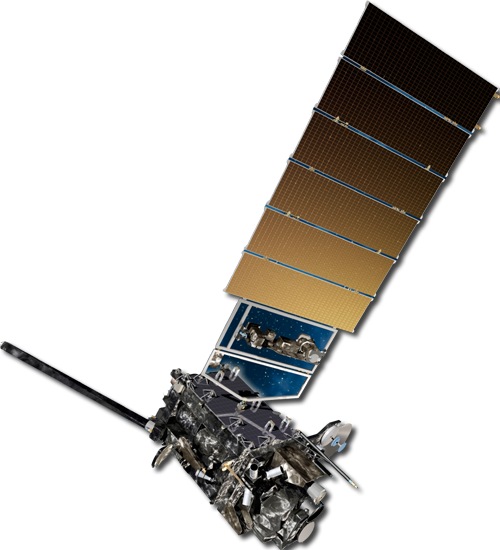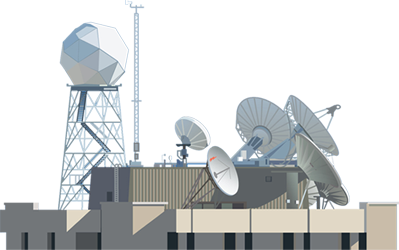Monitoring the Global Environment

Assessment Questions
- What are the three main greenhouse gases presented in this module? Please write out the full names and the chemical nomenclature.
- Explain the term "greenhouse gas"
- If POES flies so much closer to the Earth than GOES, why bother using instruments on GOES to monitor things like forest fires or biomass burning?
Download a printable Assessment Questions worksheet: WORD | PDF
Problem Based Learning Questions on Biomass Burning and Global Climate Change
Teachers are encouraged to divide the class into two main groups and have half of
the class work on the Biomass Burning PBL assignment and the other half on the Global
Climate change PBL assignment. These two groups should be further subdivided into groups
of 4 or 5 students so that more than one group will present findings on the same topic.
Students should use the following PBL Model to tackle these two assignments:
- Read and analyze the scenario and situation. Here students simply check their understanding of the scenario. They shouldn’t start thinking about potential solutions or looking for information, just discuss or reflect upon how they see the problem at hand.
- List hypotheses, ideas, or hunches. Everyone has some initial theories or hypotheses about the cause of the problem or ideas about how to solve the problem. These need to be listed; they will be supported or refuted as investigations proceeds.
- List what is known. Drawing from prior knowledge and the information that is included in the scenario students should make a list of everything they know.
- List what is unknown. Students should prepare a list of questions they think need to be answered to solve the problem. Several types of questions may be appropriate. Some may address concepts or principles that need to be learned in order to address the situation. Other questions may be in the form of requests for more information. These questions will guide research that may take place on the Internet, in the library, or with other sources.
- List what needs to be done. Plan the investigation. Such actions may include questioning an expert, getting online data, or visiting a library to find answers to the questions developed in Step 4. When working with a team, divide the duties.
- Develop a problem statement. A problem statement is a one or two sentence idea that clearly identifies what you are trying to solve, produce, respond to, test, or find out.
- Gather information. Students will gather, organize, analyze, and interpret information from multiple sources and then exchange ideas; think about solutions; weigh alternatives; and consider the pros and cons of potential courses of action. As more information is gathered, the problem statement may be refined or altered. Or, based upon your research data, a recommended solution or opinion may be appropriate.
- Analize Information. This step might be taking place concurrently with step 7 as
students collect information. Students will need to complete a thorough analysis
of the problem and suggest some solutions. In the process, students should show cause
effect relationships following an Earth System Science (ESS) analysis. Our Earth
is a system of individual parts, or spheres, that work together as a complex system.
The four major spheres are the lithosphere (land), hydrosphere (water), biosphere
(living things), and atmosphere.
Changes continually occur within the Earth's four major spheres. Such changes are called events. An event can cause changes to occur in one or more of the Earth's four spheres. An event can also be the affect of changes in one or more of the Earth's four spheres. The two-way, cause and effect relationship between an event and a sphere is called an interaction. Studying the interactions between and among events and the Earth's spheres is called Earth system science. After researching the scenario students should map out the interactions between the event (deforestation or climate change) and the spheres. - Present findings. Students should write a written report assessing the problem including highlights from steps 1 through 8, specifically: a background section; a problem statement; an hypothesis; and an Earth System Science analysis. Groups should prepare a presentation in which they make recommendations, predictions, inferences, or other appropriate resolutions of the problem. Ideally, students would be required to develop a multimedia presentation using images, graphics, or sound and be prepared to support the positions they take.
PBL Assignment 1: Biomass Burning in South America
An international community of scientists, government officials, business and industry representatives will convene in Brazil to discuss concerns over biomass burning and global deforestation. The United Nations has contacted several different research groups to examine the cumulative effects of deforestation and draw some conclusions about:
- the economic conditions that promote biomass burning;
- air quality degradation for citizens of S. America;
- the fate of the world's rainforests; and
- the connection between deforestation and the health of the planet.
Your research group has been tasked to analyze the cause-and-effect relationships that exist among Earth systems as a result of rainforest destruction. After developing a problem statement, hypothesis, and doing an Earth Sytem Science analysis, the written results of your analysis should include (but not be limited to) the hazards of continued rain forest destruction, the use of satellite technology to study biomass burning, and recommendations for future courses of action. A multi-media presentation is also required.
PBL Assignment 2: Global Climate Change
As we begin the 21st century, a growing amount of evidence confirms that humankind has altered the ecology of the planet and may be contributing to the global warming to a significant degree. The United States congress is convening to develop a responsible course of action for future policy initiatives. Your team of scientists have been tasked to:
- examine the causes and effects of global warming; and
- determine (and document) whether global warming is evident in the state where you live.
Your written report should include a problem statement, some initial ideas or hypothesis, and a detailed analysis of the cause-and-effect relationships that exist among Earth systems as a result of a warming climate. Using your analysis, provide suggestions to minimize these causes and effects in the form of a policy recommendation to the Governor of your state. Using evidence supplied by satellite technology, develop a multi-media presentation that includes a policy recommendation for the Governor of your state.
| Next Module |





